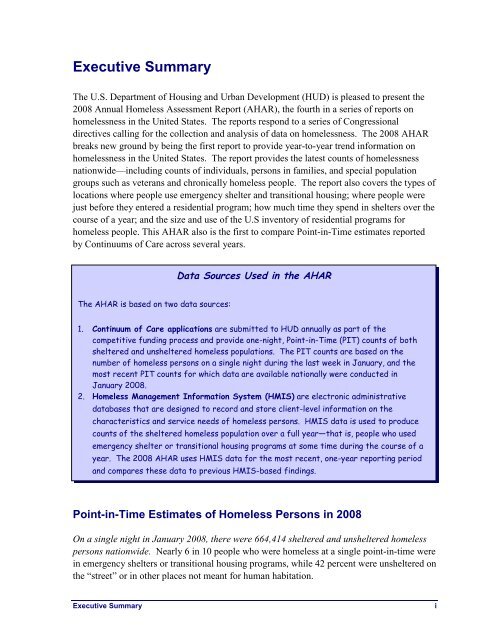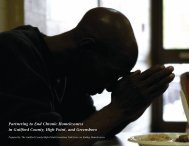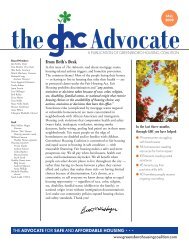data - Greensboro Housing Coalition
data - Greensboro Housing Coalition
data - Greensboro Housing Coalition
Create successful ePaper yourself
Turn your PDF publications into a flip-book with our unique Google optimized e-Paper software.
Executive Summary<br />
The U.S. Department of <strong>Housing</strong> and Urban Development (HUD) is pleased to present the<br />
2008 Annual Homeless Assessment Report (AHAR), the fourth in a series of reports on<br />
homelessness in the United States. The reports respond to a series of Congressional<br />
directives calling for the collection and analysis of <strong>data</strong> on homelessness. The 2008 AHAR<br />
breaks new ground by being the first report to provide year-to-year trend information on<br />
homelessness in the United States. The report provides the latest counts of homelessness<br />
nationwide—including counts of individuals, persons in families, and special population<br />
groups such as veterans and chronically homeless people. The report also covers the types of<br />
locations where people use emergency shelter and transitional housing; where people were<br />
just before they entered a residential program; how much time they spend in shelters over the<br />
course of a year; and the size and use of the U.S inventory of residential programs for<br />
homeless people. This AHAR also is the first to compare Point-in-Time estimates reported<br />
by Continuums of Care across several years.<br />
Data Sources Used in the AHAR<br />
The AHAR is based on two <strong>data</strong> sources:<br />
1. Continuum of Care applications are submitted to HUD annually as part of the<br />
competitive funding process and provide one-night, Point-in-Time (PIT) counts of both<br />
sheltered and unsheltered homeless populations. The PIT counts are based on the<br />
number of homeless persons on a single night during the last week in January, and the<br />
most recent PIT counts for which <strong>data</strong> are available nationally were conducted in<br />
January 2008.<br />
2. Homeless Management Information System (HMIS) are electronic administrative<br />
<strong>data</strong>bases that are designed to record and store client-level information on the<br />
characteristics and service needs of homeless persons. HMIS <strong>data</strong> is used to produce<br />
counts of the sheltered homeless population over a full year—that is, people who used<br />
emergency shelter or transitional housing programs at some time during the course of a<br />
year. The 2008 AHAR uses HMIS <strong>data</strong> for the most recent, one-year reporting period<br />
and compares these <strong>data</strong> to previous HMIS-based findings.<br />
Point-in-Time Estimates of Homeless Persons in 2008<br />
On a single night in January 2008, there were 664,414 sheltered and unsheltered homeless<br />
persons nationwide. Nearly 6 in 10 people who were homeless at a single point-in-time were<br />
in emergency shelters or transitional housing programs, while 42 percent were unsheltered on<br />
the “street” or in other places not meant for human habitation.<br />
Executive Summary<br />
i




